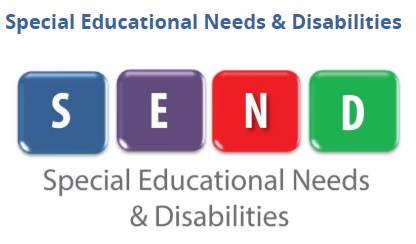
Students with Special Educational Needs and Disabilities [SEND]
My interventions, advise and efforts to date have been aimed to students without specific needs. I am now looking at what provision is available for our SEND students and how I can support them and their tutors.
SEND students will have difficulties with:
- Communication and interaction
- Cognition and learning
- Behaviour and social development
- Physical or medical needs
Differentiated and personalised, even 1:1 teaching is required, rather than the teacher teaching from the end of a classroom and hoping to keep order and anyone engaged.
Personalisation and carefully structured lessons are key.
The aim is to provide help so that students can access the parts of the general curriculum that is available to all students. It is at the frontline of accessibility. Assessment is important as there is a constant need to understand and develop students’ progress. Observation is equally important.
Some things I can read about (the rest I will have to pick up first hand)
- If too detailed some students may feel threatened and disillusioned.
- If the challenge is too great, work becomes boring and any effort is a waste of time.
Suggestions include:
- Creating a self-compiled visual dictionary for subject-specific vocabulary
- Chunking the work
- Using visual clues
- Having a ‘lesson menu’ and tick off as the student completes tasks so that they can identify their own progress.
Some specific suggestions include:
Unable to focus (ADHD)
- Small sections
- Have ample ‘time out’
- Used realistic timed targets
- Phased classwork and homework
- Reading and writing is a challenge
Dyslexic
- Use of coloured overlays to reduce glare and jumping letters
- Keep instructions simple and short
And in general:
- Facilitate 1:1 tutorials
- Record lessons by phone or laptop
- Use visuals to support written text
SEND students need to be catered for in a non-discriminatory way, in an inclusive environment, can only enhance the self image and self worth of young people.
Objectives
To achieve a higher level of personal self-sufficiency and success.
Integration can reduce social stigmas and improve academic achievement.
Where can technology help?
A special education program should be customised to address each individual student’s unique needs.
Individualised Education Program
This will address each student’s unique learning issues and include specific educational goals.
To help them participate in the educational environment as much as possible.
There are five broad categories of provision
-
Inclusion
-
Mainstreaming
-
Segregation
-
Exclusion
-
Co-teaching
Individual Education Plan (IEP)
- Targets
- Provisions
- Outcomes
What strategies will be used
What provision put in place?
Identifiable outcomes to monitor progress.
And include:
Likes, dislikes and anxieties
Home-based tasks
Specific: it is clear what the student should be working towards.
Measurable: it is clear when the target has been achieved.
Achievable: for the individual student.
Relevant: to the student’s needs and circumstances.
Time-bound: targets are to be achieved by a specified time.
There are 14 categories under special education (in the US):
-
Autism
-
Deaf-blindness
-
Deafness
-
Developmental delay
-
Emotional and behavioral disorders
-
Hearing impairment
-
Intellectual disability (formerly referred to as mental retardation)
-
Multiple disabilities
-
Orthopedic impairment
-
Other health impairment
-
Specific learning disability
-
Speech or language impairment
-
Traumatic brain injury
-
Visual impairment, including blindness